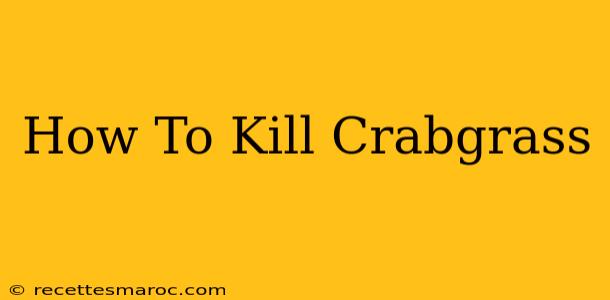Crabgrass. Just the name conjures up images of unsightly, sprawling patches ruining your otherwise perfect lawn. This aggressive weed is a homeowner's nightmare, but don't despair! This comprehensive guide will equip you with the knowledge and strategies to effectively kill crabgrass and reclaim your lush, green paradise.
Understanding Crabgrass: Its Life Cycle and Habits
Before we delve into eradication methods, understanding crabgrass is crucial. This annual weed germinates in spring, spreads rapidly throughout the summer, and dies off in the fall. It thrives in warm temperatures and full sun, making it particularly prevalent in neglected or poorly maintained lawns. Knowing its life cycle helps you time your attack for maximum effectiveness.
Key Characteristics of Crabgrass:
- Rapid Growth: Crabgrass spreads incredibly quickly, often forming dense mats that choke out desirable grasses.
- Shallow Roots: Its shallow root system makes it relatively easy to remove, especially when young.
- Seed Production: Crabgrass produces a massive amount of seeds, ensuring its return year after year if not properly controlled.
Effective Methods to Kill Crabgrass
There are several effective methods for killing crabgrass, each with its pros and cons. The best approach often depends on the severity of the infestation and your personal preferences.
1. Pre-Emergent Herbicides: Preventing the Problem Before It Starts
Pre-emergent herbicides are applied before crabgrass germinates, typically in early spring. These prevent seeds from sprouting, effectively stopping the problem before it begins. They're best used as a preventative measure, combined with other methods for existing crabgrass. Important Note: Pre-emergent herbicides can also prevent desirable grasses from germinating, so timing is crucial. Follow product instructions carefully.
2. Post-Emergent Herbicides: Targeting Existing Crabgrass
Post-emergent herbicides are applied after crabgrass has already emerged. These kill existing crabgrass plants. They're effective, but timing is critical—you need to apply them when the crabgrass is actively growing, typically in spring or early summer. Many post-emergent herbicides are selective, meaning they target crabgrass while leaving desirable grasses unharmed. However, always carefully read and follow the label instructions to avoid damaging your lawn.
3. Manual Removal: For Small Infestations
For small patches of crabgrass, manual removal can be effective. This involves digging up the crabgrass plants, roots and all. While labor-intensive, it’s environmentally friendly and avoids the use of chemicals. This method works best for small, isolated infestations.
4. Cultural Practices: Creating an Unfavorable Environment
Creating an environment unfavorable for crabgrass can help suppress its growth. This involves:
- Thick, healthy lawn: A dense, healthy lawn will out-compete crabgrass for resources like sunlight, water, and nutrients.
- Proper mowing height: Mowing your lawn at the proper height encourages desirable grass growth and discourages crabgrass.
- Regular fertilization and watering: A well-fed and hydrated lawn is better equipped to resist weeds.
- Thatch removal: Thatch accumulation provides a haven for crabgrass seeds.
Choosing the Right Approach: A Personalized Strategy
The best approach for killing crabgrass depends on several factors, including the size of the infestation, your tolerance for chemicals, and your budget. For small infestations, manual removal or a combination of cultural practices and post-emergent herbicides might suffice. Larger infestations might require a more comprehensive approach, combining pre-emergent and post-emergent herbicides with improved lawn care practices.
Maintaining a Crabgrass-Free Lawn: Ongoing Maintenance
Killing crabgrass is only half the battle. Preventing its return requires ongoing maintenance. Regular fertilization, proper watering, and mowing at the correct height all contribute to a healthy lawn that is less susceptible to weed invasion. Continue using pre-emergent herbicides as a preventative measure each spring.
By understanding crabgrass's lifecycle and employing the appropriate strategies, you can effectively eliminate this pesky weed and enjoy a beautiful, weed-free lawn for years to come. Remember to always follow product instructions carefully when using herbicides.

